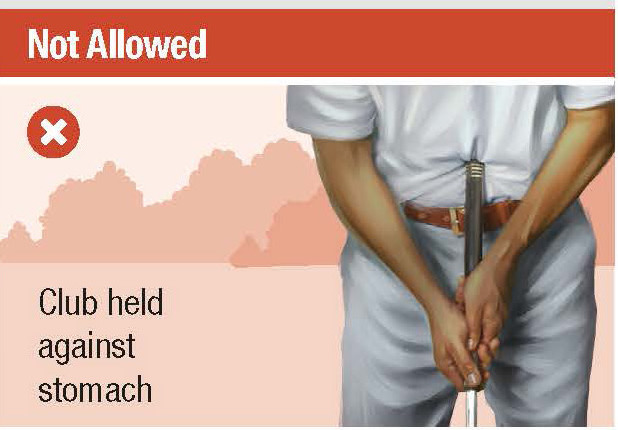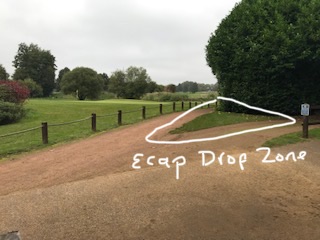eCAP Links
Rules Page
© Kendosan 2023
Rule Update
9.5b
Penalty for Lifting or Deliberately Touching Ball or Causing It to Move
If the opponent lifts or deliberately touches the player’s ball at rest or causes it to move, the opponent gets one penalty stroke.
Under rule 14.6.a, if a stroke is made from the Teeing area, the original ball or another ball must be played from anywhere inside the teeing area (and may be teed).
See page 85, R&A rules.
Anchoring the putter - Rule 10


2
R&A Rules 2019
Ball lost or Out of Bounds?
If your ball is lost or out of bounds, your only option is to play again under penalty of stroke and distance. If your ball might be lost outside a penalty area or be out of bounds, you should play a provisional ball. Remember to announce you are going to play a provisional ball. You have three minutes to find your ball from when you start to look for it.
Stroke and Distance explained
The term stroke and distance means that the player both:
Gets one penalty stroke, and
Loses the benefit of any gain of distance towards the hole from the spot where the previous stroke was made.
>>>>>>>>>>>>>>>>>>>>>>>>>>>>>>>>>> NOTE:
A new rule allows that a local rule can be put in place that allows a drop to be taken in the vicinity of where the ball disappeared. So, no stroke and distance and hence a quicker round. However, this would incur two penalty strokes!
>>>>>>>>>>>>>>>>>>>>>>>>>>>>>>>>>
Relying on player integrity:
A player’s “reasonable judgment” when estimating or measuring a spot, point, line, area or distance will be upheld, even if video evidence later shows it to be wrong; and elimination of announcement procedures when lifting a ball to identify it or to see if it is damaged.
Dropping procedure:
Drop from knee height.
Penalties removed:
No penalty for accidentally moving ball on the green or whilst searching for a ball. No penalty for a double hit. Touching the ground or water in a penalty area is now allowed.
Relaxed bunker rules:
1. you can remove impediments, 2. take relief for an imbedded ball outside the bunker (two stroke penalty) 3. no penalty if the ball hits you off of the bunker wall.
Embedded Ball:
You may take relief if your ball is embedded anywhere (except in sand) in the general area.
Pace of play:
Searching for a lost ball, time reduced to 3 minutes, only 40 seconds allowed to make a stroke. Ready golf encouraged. Players may putt without having the flagstick attended or removed.
Player integrity:
This is assumed on matters of judgment and there is no longer a need to broadcast your intention to lift a ball.
Measuring in taking relief:
The golfer’s relief area will be measured by using the longest club to measure one club-length or two club-lengths, depending on the situation, providing a consistent process for golfers to establish his/her relief area. (Key change: the proposed Rules released in 2017 suggested a 20-inch or 80-inch standard measurement).
Removing the penalty for a double hit:
The penalty stroke for accidentally striking the ball more than once in the course of a stroke has been removed. Golfers will simply count the one stroke they made to strike the ball. (Key change: the proposed Rules released in 2017 included the existing one-stroke penalty).
Balls Lost or Out of Bounds, Alternative to Stroke and Distance:
A new Local Rule will now be available in January 2019, permitting committees to allow golfers the option to drop the ball in the vicinity of where the ball is lost or out of bounds (including the nearest fairway area), under a two-stroke penalty. It addresses concerns raised at the club level about the negative impact on pace of play when a player is required to go back under stroke and distance. The Local Rule is not intended for higher levels of play, such as professional or elite level competitions. (Key change: this is a new addition to support pace of play)
Elimination or reduction of “ball moved” penalties:
There will be no penalty for accidentally moving a ball on the putting green or in searching for a ball; and a player is not responsible for causing a ball to move unless it is “virtually certain” that he or she did so.
Relaxed putting green rules:
There will be no penalty if a ball played from the putting green hits an unattended flagstick in the hole; players may putt without having the flagstick attended or removed. Players may repair spike marks and other damage made by shoes, animal damage and other damage on the putting green and there is no penalty for merely touching the line of putt.
Relaxed rules for “penalty areas” (currently called “water hazards”):
Red and yellow-marked penalty areas may cover areas of desert, jungle, lava rock, etc., in addition to areas of water; expanded use of red penalty areas where lateral relief is allowed; and there will be no penalty for moving loose impediments or touching the ground or water in a penalty area.
Relaxed bunker rules:
There will be no penalty for moving loose impediments in a bunker or for generally touching the sand with a hand or club. A limited set of restrictions (such as not grounding the club right next to the ball) is kept to preserve the challenge of playing from the sand; however, an extra relief option is added for an unplayable ball in a bunker, allowing the ball to be played from outside the bunker with a two-stroke penalty.
Pace-of-play support:
Reduced time for searching for a lost ball (from five minutes to three); affirmative encouragement of “ready golf” in stroke play; recommending that players take no more than 40 seconds to play a stroke and other changes intended to help with pace of play.
UP
3
ECAP Rules Section
New Rule 18th Drop Zone

If the ball goes into the trees/bushes then a player can take a (one-stroke) penalty drop in the ‘ECAP Unofficial Drop Zone’. The proposed drop zone is shown in the attached photograph which shows the 18th green from the shoe cleaning area.
Rubbish bunkers
With immediate effect, a new eCAP local rule is being introduced (yes, it's been sanctioned through the unofficial committee). If your ball comes to rest in an unraked, washed out, smooth lying bunker, it is permissible to lift the ball, rake the bunker and place the ball (not drop it) in the newly raked area (but not closer to the hole!).
Marking Your Ball

“Players are reminded that their ball should be sufficiently well marked so that it is not necessary to lift the ball to identify it other than in exceptional circumstances”. see Rule 14
Hence forward, lifting your ball for no good reason will incur a one point penalty. With winter rules in play, that only applies if you are off the fairway.
Players are reminded....Rule 14
Hence forward, lifting your ball for no good reason will incur a one point penalty. You may only lift, without penalty on the fairway.
Slow Play
After our round on Thursday (17 Nov), the Club Manager (aka Maureen!) came and had a word with the six of us. She has received a number of complaints, both verbal and written, about the pace of play of the ECAP Group. She wasn’t over-the-top but was keen to see if there were things that could be done to speed things up.
Now, before anyone throws their hands up in denial, it is, certainly in my view, a fair cop. We have discussed it amongst ourselves on several occasions; four and a half hours is unacceptable for a round of golf. At the very most, it should be somewhere between three and a half and 4 hours.
I’m not going to list everything that could be done to speed things up but here are 7 things which we should all start doing from next Monday.
DO
a. where it is safe to do so, go straight to your ball and play your shot – the ‘honour’ system (i.e. playing in turn) does not apply. If it is safe to do so, play your shot as soon as possible;
b. this principle also applies on the greens – putt when ready (and, if necessary and possible, read your putt while others are putting out);
c. play your own shot before you help others to look for a ball;
d. putt out if you are within about 3-4ft of the hole (i.e. do not mark your ball if it is within this distance);
e. take a provisional if there is any doubt about finding your ball (see also below);
f. pick up as soon as you cannot score on a hole (i.e. no knocking a ball up for practice purposes).
DON’T
g. take more than 3 minutes to look for your ball (see also below).
With regards to e. (provisional ball) we will also introduce a penalty rule. If a ball is lost and a provisional ball has not been played then a new ball can be dropped with a two-stroke penalty.
With regards to g. (three minutes searching) with immediate effect the lowest handicapper in each group will be responsible for deciding when three minutes is up. I suggest he/she simply counts to 180 (quietly and to themselves) and declares when the time is up. The time starts from when the player who lost the ball starts looking. The timekeeper’s decision is final and will not be disputed. When time is up the searching stops immediately and either a penalty is taken (as in the previous paragraph) or the player ‘picks up’.
It is appreciated that most, if not all, of us are polite and courteous individuals who want to help people look for their balls or politely allow people to play in turn. However, as has been evidenced, the pace of play requires us to make a few changes to our behaviours. If we can shave just a couple of minutes off the time taken for each hole then we will easily come in under four hours.
Finally, as we try to embed these things into the way we play, we should all be prepared to have things pointed out/reminded to us in the best interests of the group. A quiet observation here and there should be sufficient and nobody should take it as undue personal criticism.
Let’s give it a go and see how we get on in the next couple of weeks.
Some thoughts from Bill
I support the proposal to proceed forward from Stuart. I personally have observed the actions that have been highlighted contributing to slow play. I also find myself ( As many of us are) moving slower as a function of age and physical constraints and that is understandable but these actions proposed will improve our pace of play.
I would add a number of my own observations if you need to wait for another to play select your cub from the bag and be ready to play as soon as they have played. On the tee have your club, ball and tee peg ready to go while waiting for others to play.
If you as a group lose a hole to the group in front let whoever the group is behind through. If the way is clear when you go to the Tee play and then mark up your card.




